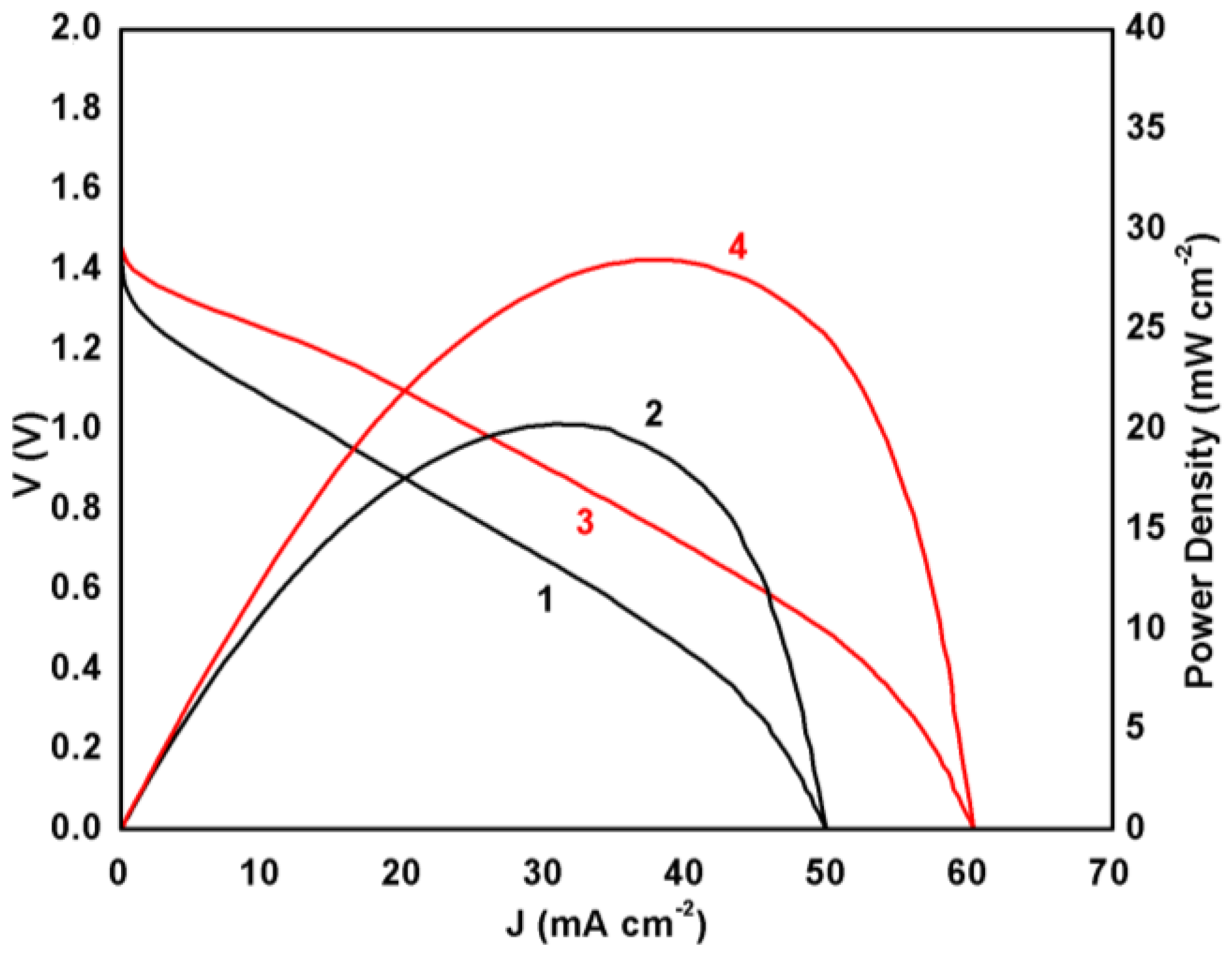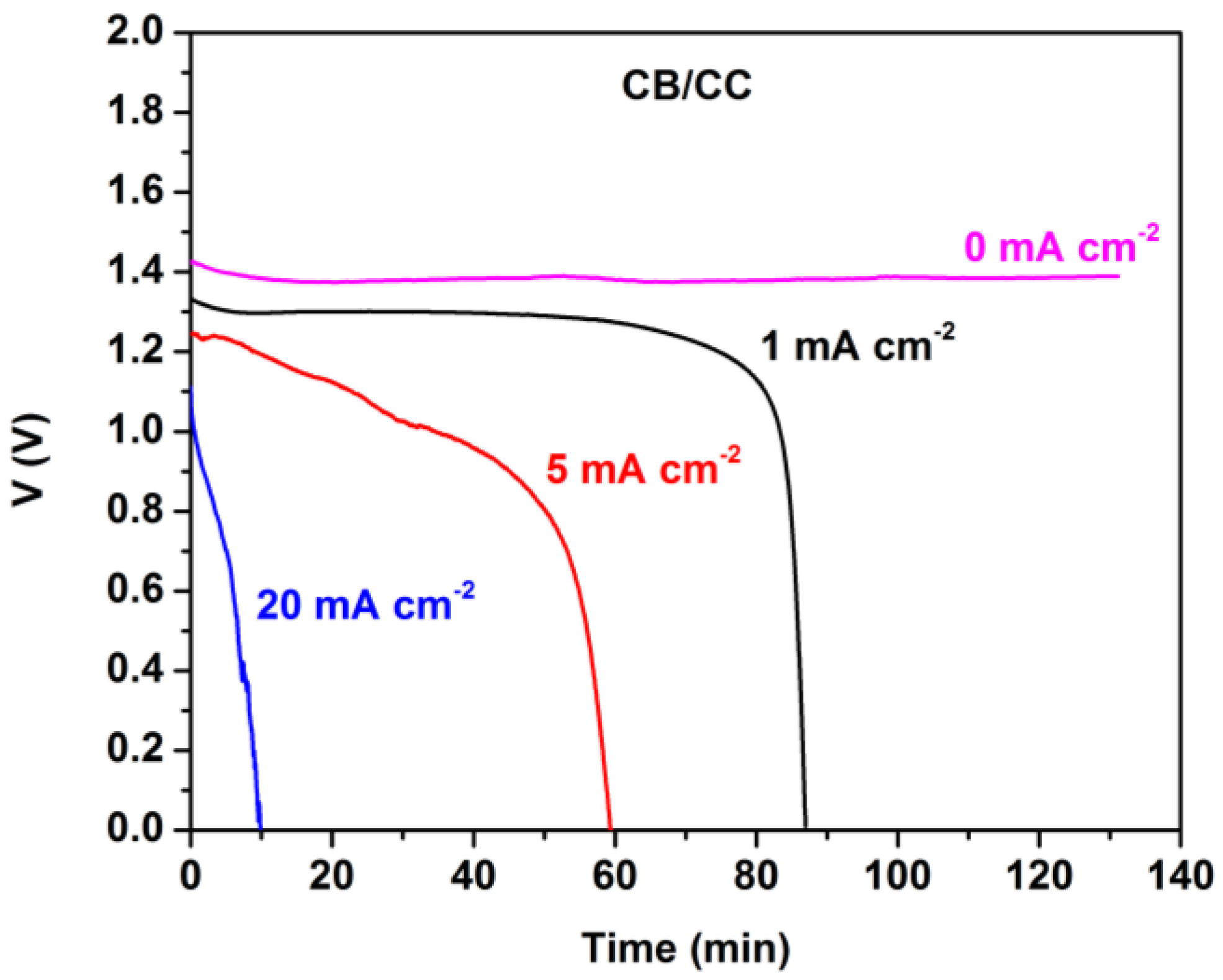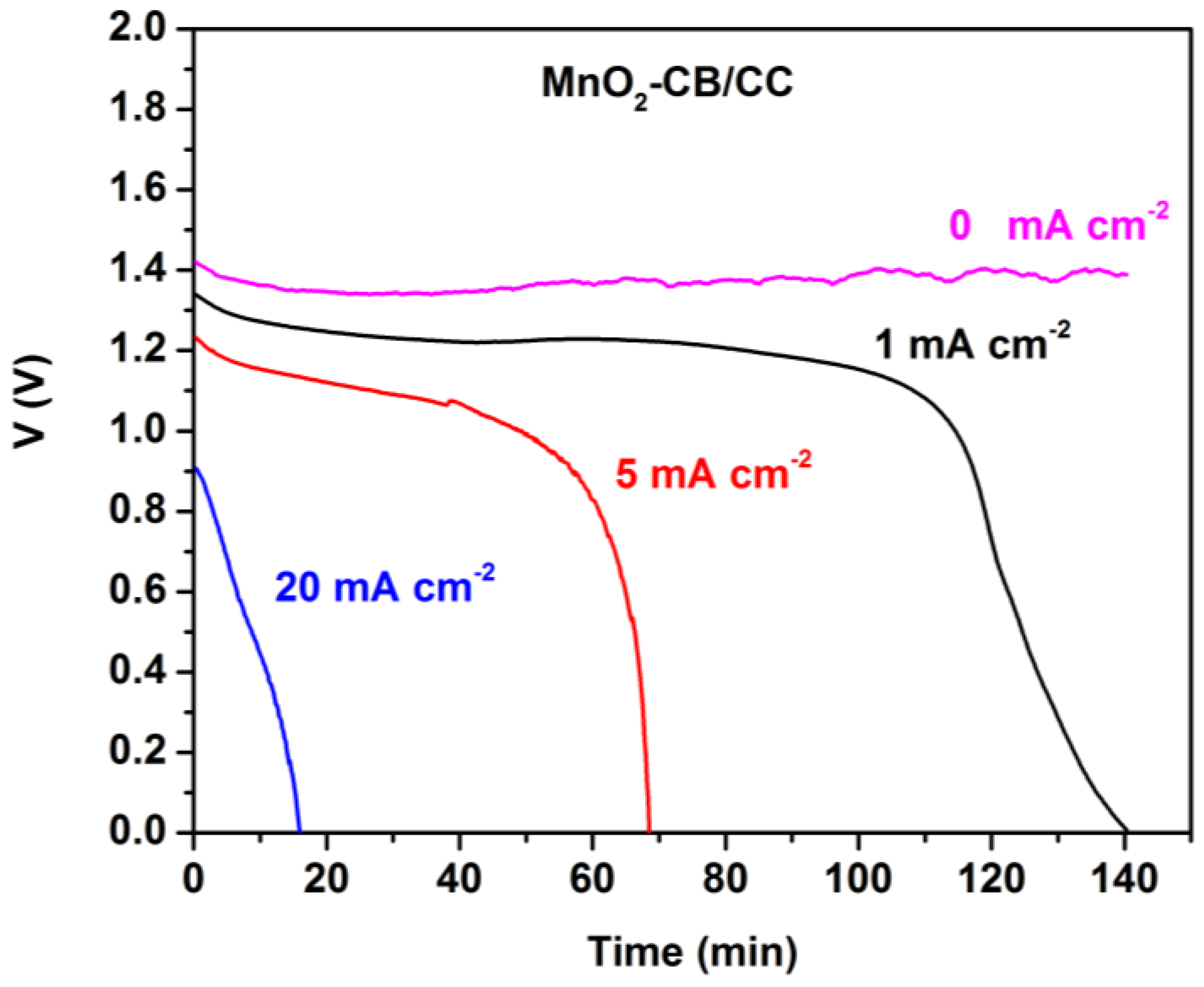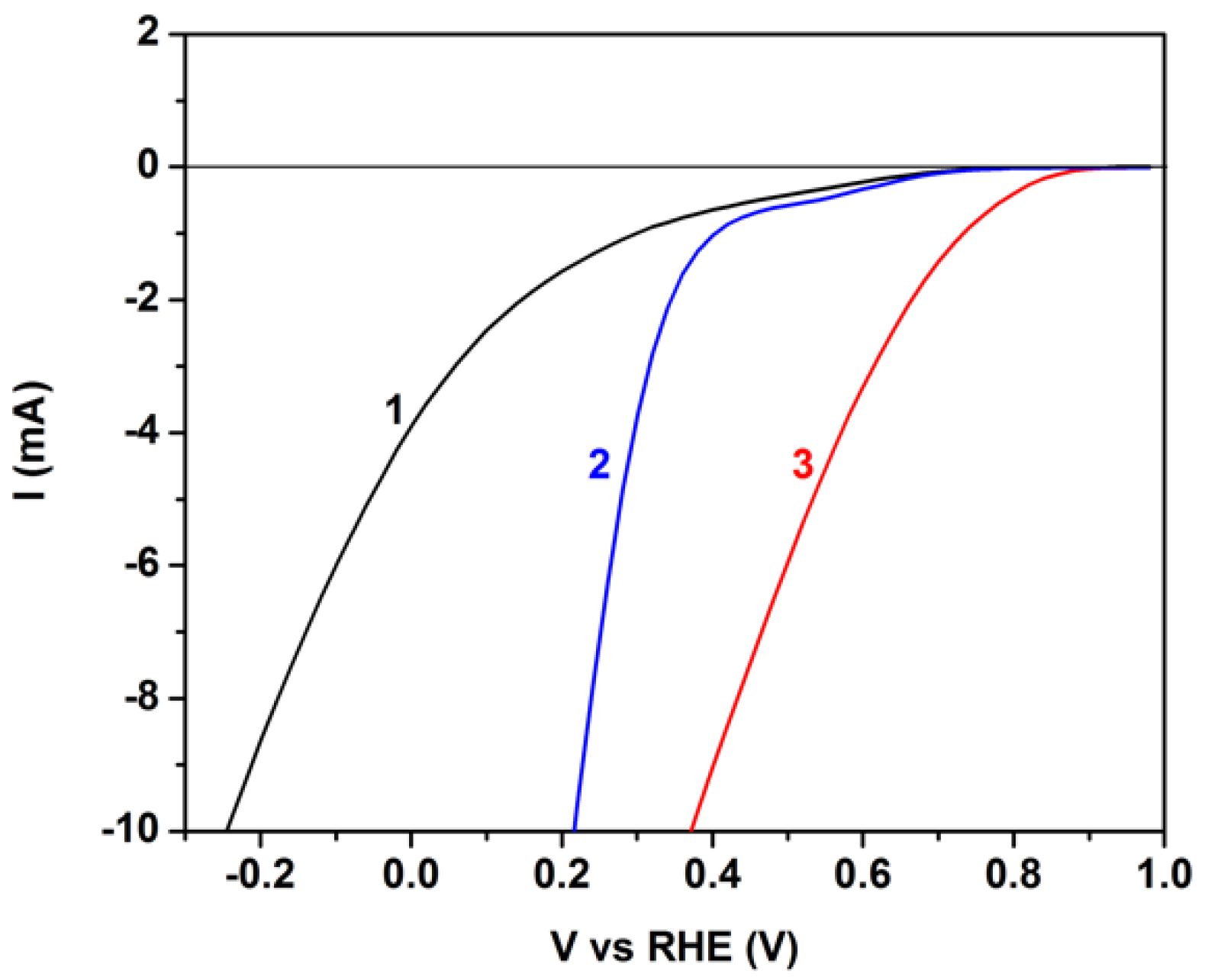Study of a Thin Film Aluminum-Air Battery
Abstract
1. Introduction
2. Materials and Methods
2.1. Materials
2.2. Preparation of the Anode Electrode
2.3. Construction of the CB/CC and the MnO2-CB/CC Cathode Electrode
2.4. Description of the Device
2.5. Measurements and Characterizations
3. Results and Discussion
3.1. Material Characterization
3.2. Electric Characteristics of the Thin Film Al-Air Battery
3.3. Electrochemical Characterization of the MnO2-CB/CC vs. CB/CC Electrode
4. Conclusions
Author Contributions
Funding
Acknowledgments
Conflicts of Interest
References
- Raptis, D.; Seferlis, A.K.; Mylona, V.; Politis, C.; Lianos, P. Electrochemical hydrogen and electricity production by using anodes made of commercial aluminum. Int. J. Hydrog. Energy 2019, 44, 1359–1365. [Google Scholar] [CrossRef]
- Katsoufis, P.; Mylona, V.; Politis, C.; Avgouropoulos, G.; Lianos, P. Study of some basic operation conditions of an Al-air battery using technical grade commercial aluminum. J. Power Sources 2020, 450, 227624. [Google Scholar] [CrossRef]
- Liu, Y.; Sun, Q.; Li, W.; Adair, K.R.; Li, J.; Sun, X. A comprehensive review on recent progress in aluminium—Air batteries. Green Energy Environ. 2017, 2, 246–277. [Google Scholar] [CrossRef]
- Zhu, C.; Ma, Y.; Zang, W.; Guan, C.; Liu, X.; Pennycook, S.J.; Wang, J.; Huang, W. Conformal dispersed cobalt nanoparticles in hollow carbon nanotube arrays for flexible Zn-air and Al-air batteries. Chem. Eng. J. 2019, 369, 988–995. [Google Scholar] [CrossRef]
- Wang, Y.; Pan, W.; Kwog, H.; Lu, X.; Leung, D.Y.C. Low cost Al-air batteries with paper-based solid electrolyte. Energy Procedia 2019, 158, 522–527. [Google Scholar] [CrossRef]
- Eftekhari, A.; Corrochanoc, P. Electrochemical energy storage by aluminum as a lightweight and cheap anode/charge carrier. Sustain. Energy Fuels 2017, 1, 1246–1265. [Google Scholar] [CrossRef]
- Wang, Y.; Pan, W.; Kwok, H.Y.H.; Zhang, H.; Lu, X.; Leung, D.Y.C. Liquid-free Al-air batteries with paper-based gel electrolyte: A green energy technology for portable electronics. J. Power Sources 2019, 437, 226896–226907. [Google Scholar] [CrossRef]
- Wang, Y.; Kwok, H.Y.H.; Pan, W.; Zhang, Y.; Zhang, H.; Lu, X.; Leung, D.Y.C. Combining Al-air battery with paper-making industry, a novel type of flexible primary battery technology. Electrochim. Acta 2019, 319, 947–957. [Google Scholar] [CrossRef]
- Di Palma, T.M.; Migliardini, F.; Gaele, M.F.; Corbo, P. Physically cross-linked xanthan hydrogels as solid electrolytes for Al/air batteries. Ionics 2019, 25, 4209–4217. [Google Scholar] [CrossRef]
- Wang, M.; Li, Y.; Fang, J.; Villa, C.J.; Xu, Y.; Hao, S.; Li, J.; Liu, Y.; Wolverton, C.; Chen, X.; et al. Superior Oxygen Reduction Reaction on Phosphorus—Doped Carbon Dot/Graphene Aerogel for All-Solid-State Flexible Al–Air Batteries. Adv. Energy Mater. 2019, 10, 1902736. [Google Scholar] [CrossRef]
- Hasvold, O.; Johansen, K.H.; Mollestad, O.; Forseth, S.; Størkersen, N. The alkaline aluminium hydrogen peroxide power source in the Hugin II unmanned underwater vehicle. J. Power Sources 1999, 80, 254–260. [Google Scholar] [CrossRef]
- Zhang, H.; Yang, Y.; Liu, T.; Chang, H. Boosting the Power-Generation Performance of Micro-Sized Al-H2O2 Fuel Cells by Using Silver Nanowires as the Cathode. Energies 2018, 11, 2316. [Google Scholar] [CrossRef]
- Kuo, Y.L.; Wu, C.C.; Chang, W.S.; Yang, C.R.; Chou, H.L. Study of Poly (3, 4-ethylenedioxythiophene)/MnO2 as Composite Cathode Materials for Aluminum-Air Battery. Electrochim. Acta 2015, 176, 1324–1331. [Google Scholar] [CrossRef]
- Khan, Z.; Park, S.; Hwang, S.M.; Yang, J.; Lee, Y.; Song, H.-K.; Kim, Y.; Ko, H. Hierarchical urchin-shaped α-MnO2 on graphenecoated carbon microfibers: A binder-free electrode for rechargeable aqueous Na–air battery. NPG Asia Mater. 2016, 8, 294. [Google Scholar] [CrossRef]
- Zhang, S.; Su, W.; Wei, Y.; Liu, J.; Li, K. Mesoporous MnO2 structured by ultrathin nanosheet as electrocatalyst for oxygen reduction reaction in air-cathode microbial fuel cell. J. Power Sources 2018, 401, 158–164. [Google Scholar] [CrossRef]
- Tremouli, A.; Karydogiannis, I.; Pandis, P.K.; Papadopoulou, K.; Argirusis, C.; Stathopoulos, V.N.; Lyberatos, G. Bioelectricity production from fermentable household waste extract using a single chamber microbial fuel cell. Energy Procedia 2019, 161, 2–9. [Google Scholar] [CrossRef]
- Majidi, M.R.; Farahani, F.S.; Hosseini, M.; Ahadzadeh, I. Low-cost nanowired α-MnO2/C as an ORR catalyst in air-cathode microbial fuel cell. Bioelectrochemistry 2019, 125, 38–45. [Google Scholar] [CrossRef] [PubMed]
- Priya, A.D.; Setty, Y.P. Effect of MnO2: rGO ratio on the performance of a microbial fuel cell: An experimental optimization study. Energy Source Part A 2019, 41, 600–610. [Google Scholar] [CrossRef]
- Huang, B.; Zhang, X.; Cai, J.; Liu, W.; Lin, S. A novel MnO2/rGO composite prepared by electrodeposition as a non-noble metal electrocatalyst for ORR. J. Appl. Electrochem. 2019, 49, 767–777. [Google Scholar] [CrossRef]
- Hopkins, B.J.; Shao-Horn, Y.; Hart, D.P. Suppressing corrosion in primary aluminum—Air batteries via oil displacement. Science 2018, 362, 658–661. [Google Scholar] [CrossRef] [PubMed]







© 2020 by the authors. Licensee MDPI, Basel, Switzerland. This article is an open access article distributed under the terms and conditions of the Creative Commons Attribution (CC BY) license (http://creativecommons.org/licenses/by/4.0/).
Share and Cite
Katsoufis, P.; Katsaiti, M.; Mourelas, C.; Andrade, T.S.; Dracopoulos, V.; Politis, C.; Avgouropoulos, G.; Lianos, P. Study of a Thin Film Aluminum-Air Battery. Energies 2020, 13, 1447. https://doi.org/10.3390/en13061447
Katsoufis P, Katsaiti M, Mourelas C, Andrade TS, Dracopoulos V, Politis C, Avgouropoulos G, Lianos P. Study of a Thin Film Aluminum-Air Battery. Energies. 2020; 13(6):1447. https://doi.org/10.3390/en13061447
Chicago/Turabian StyleKatsoufis, Petros, Maria Katsaiti, Christos Mourelas, Tatiana Santos Andrade, Vassilios Dracopoulos, Constantin Politis, George Avgouropoulos, and Panagiotis Lianos. 2020. "Study of a Thin Film Aluminum-Air Battery" Energies 13, no. 6: 1447. https://doi.org/10.3390/en13061447
APA StyleKatsoufis, P., Katsaiti, M., Mourelas, C., Andrade, T. S., Dracopoulos, V., Politis, C., Avgouropoulos, G., & Lianos, P. (2020). Study of a Thin Film Aluminum-Air Battery. Energies, 13(6), 1447. https://doi.org/10.3390/en13061447






